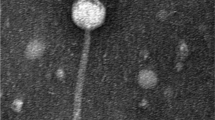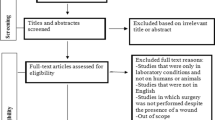Abstract
Antibiotic resistance in Pseudomonas aeruginosa biofilms necessitates the need for novel antimicrobial therapy with anti-biofilm properties. Bacteriophages (phages) are recognized as an ideal biopharmaceutical for combating antibiotic-resistant bacteria especially when used in combination with antibiotics. However, previous studies primarily focused on using phages against of P. aeruginosa biofilms of laboratory strains. In the present study, biofilms of six P. aeruginosa isolated from cystic fibrosis and wound patients, and one laboratory strain was treated singly and with combinations of anti-Pseudomonas phage PEV20 and ciprofloxacin. Of these strains, three were highly susceptible to the phage, while one was partially resistant and one was completely resistant. Combination treatment with PEV20 and ciprofloxacin enhanced biofilm eradication compared with single treatment. Phage and ciprofloxacin synergy was found to depend on phage-resistance profile of the target bacteria. Furthermore, phage and ciprofloxacin combination formulation protected the lung epithelial and fibroblast cells from P. aeruginosa and promoted cell growth. The results demonstrated that thorough screening of phage-resistance is crucial for designing phage-antibiotic formulation. The addition of highly effective phage could reduce the ciprofloxacin concentration required to combat P. aeruginosa infections associated with biofilm in cystic fibrosis and wound patients.




Similar content being viewed by others
Abbreviations
- CF:
-
Cystic fibrosis
References
Filkins LM, O'Toole GA. Cystic fibrosis lung infections: polymicrobial, complex, and hard to treat. PLoS Pathog. 2015;11(12):e1005258–e.
Hoiby N, Ciofu O, Bjarnsholt T. Pseudomonas aeruginosa biofilms in cystic fibrosis. Future Microbiol. 2010;5(11):1663–74.
Bowler PG, Duerden BI, Armstrong DG. Wound microbiology and associated approaches to wound management. Clin Microbiol Rev. 2001;14(2):244–69.
Gonzalez MR, Fleuchot B, Lauciello L, Jafari P, Applegate LA, Raffoul W, et al. Effect of human burn wound exudate on Pseudomonas aeruginosa virulence. mSphere. 2016;1(2).
Fazli M, Bjarnsholt T, Kirketerp-Moller K, Jorgensen B, Andersen AS, Krogfelt KA, et al. Nonrandom distribution of Pseudomonas aeruginosa and Staphylococcus aureus in chronic wounds. J Clin Microbiol. 2009;47(12):4084–9.
Livermore DM. Multiple mechanisms of antimicrobial resistance in Pseudomonas aeruginosa: our worst nightmare? Clin Infect Dis. 2002;34(5):634–40.
Kirby AE, Garner K, Levin BR. The relative contributions of physical structure and cell density to the antibiotic susceptibility of bacteria in biofilms. Antimicrob Agents Chemother. 2012;56(6):2967–75.
Olszak T, Zarnowiec P, Kaca W, Danis-Wlodarczyk K, Augustyniak D, Drevinek P, et al. In vitro and in vivo antibacterial activity of environmental bacteriophages against Pseudomonas aeruginosa strains from cystic fibrosis patients. Appl Microbiol Biotechnol. 2015;99(14):6021–33.
Parasion S, Kwiatek M, Gryko R, Mizak L, Malm A. Bacteriophages as an alternative strategy for fighting biofilm development. Pol J Microbiol. 2014;63(2):137–45.
Doolittle MM, Cooney JJ, Caldwell DE. Lytic infection of Escherichia coli biofilms by bacteriophage T4. Can J Microbiol. 1995;41(1):12–8.
Harper DR, Parracho HMRT, Walker J, Sharp R, Hughes G, Werthén M, et al. Bacteriophages and biofilms. Antibiotics. 2014;3(3):270–84.
Sutherland IW, Hughes KA, Skillman LC, Tait K. The interaction of phage and biofilms. FEMS Microbiol Lett. 2004;232(1):1–6.
Coulter LB, McLean RJ, Rohde RE, Aron GM. Effect of bacteriophage infection in combination with tobramycin on the emergence of resistance in Escherichia coli and Pseudomonas aeruginosa biofilms. Viruses. 2014;6(10):3778–86.
Chaudhry WN, Concepcion-Acevedo J, Park T, Andleeb S, Bull JJ, Levin BR. Synergy and order effects of antibiotics and phages in killing Pseudomonas aeruginosa biofilms. PLoS One. 2017;12(1):e0168615.
Knezevic P, Curcin S, Aleksic V, Petrusic M, Vlaski L. Phage-antibiotic synergism: a possible approach to combatting Pseudomonas aeruginosa. Res Microbiol. 2013;164(1):55–60.
Nouraldin AAM, Baddour MM, Harfoush RAH, Essa SAM. Bacteriophage-antibiotic synergism to control planktonic and biofilm producing clinical isolates of Pseudomonas aeruginosa. Alexandria J Med. 2016;52(2):99–105.
Lin Y, Chang RYK, Britton WJ, Morales S, Kutter E, Chan HK. Synergy of nebulized phage PEV20 and ciprofloxacin combination against Pseudomonas aeruginosa. Int J Pharm. 2018;551(1–2):158–65.
Chang RYK, Wong J, Mathai A, Morales S, Kutter E, Britton W, et al. Production of highly stable spray dried phage formulations for treatment of Pseudomonas aeruginosa lung infection. Eur J Pharm Biopharm. 2017;121:1–13.
Chang RYK, Chen K, Wang J, Wallin M, Britton W, Morales S, et al. Proof-of-principle study in a murine lung infection model of antipseudomonal activity of phage PEV20 in a dry-powder formulation. Antimicrob Agents Chemother. 2018;62(2):e01714–e7.
Das T, Simone M, Ibugo AI, Witting PK, Manefield M, Manos J. Glutathione enhances antibiotic efficiency and effectiveness of DNase I in disrupting Pseudomonas aeruginosa biofilms while also inhibiting pyocyanin activity, thus facilitating restoration of cell enzymatic activity, confluence and viability. Front Microbiol. 2017;8:2429.
Gonzalez S, Fernandez L, Gutierrez D, Campelo AB, Rodriguez A, Garcia P. Analysis of different parameters affecting diffusion, propagation and survival of Staphylophages in bacterial biofilms. Front Microbiol. 2018;9:2348.
Walters MC 3rd, Roe F, Bugnicourt A, Franklin MJ, Stewart PS. Contributions of antibiotic penetration, oxygen limitation, and low metabolic activity to tolerance of Pseudomonas aeruginosa biofilms to ciprofloxacin and tobramycin. Antimicrob Agents Chemother. 2003;47(1):317–23.
Glonti T, Chanishvili N, Taylor PW. Bacteriophage-derived enzyme that depolymerizes the alginic acid capsule associated with cystic fibrosis isolates of Pseudomonas aeruginosa. J Appl Microbiol. 2010;108(2):695–702.
Briandet R, Lacroix-Gueu P, Renault M, Lecart S, Meylheuc T, Bidnenko E, et al. Fluorescence correlation spectroscopy to study diffusion and reaction of bacteriophages inside biofilms. Appl Environ Microbiol. 2008;74(7):2135–43.
Taylor PK, Yeung ATY, Hancock REW. Antibiotic resistance in Pseudomonas aeruginosa biofilms: towards the development of novel anti-biofilm therapies. Aust J Biotechnol. 2014;191:121–30.
Labrie SJ, Samson JE, Moineau S. Bacteriophage resistance mechanisms. Nat Rev Microbiol. 2010;8(5):317–27.
Sulakvelidze A, Kutter E. Bacteriophages: biology and applications. Boca Raton, FL: CRC Press; 2005.
Forti F, Roach DR, Cafora M, Pasini ME, Horner DS, Fiscarelli EV, et al. Design of a broad-range bacteriophage cocktail that reduces Pseudomonas aeruginosa biofilms and treats acute infections in two animal models. Antimicrob Agents Chemother. 2018;62(6):e02573–17.
Fu W, Forster T, Mayer O, Curtin JJ, Lehman SM, Donlan RM. Bacteriophage cocktail for the prevention of biofilm formation by Pseudomonas aeruginosa on catheters in an in vitro model system. Antimicrob Agents Chemother. 2010;54(1):397–404.
Tseng BS, Zhang W, Harrison JJ, Quach TP, Song JL, Penterman J, et al. The extracellular matrix protects Pseudomonas aeruginosa biofilms by limiting the penetration of tobramycin. Environ Microbiol. 2013;15(10):2865–78.
Nichols WW, Dorrington SM, Slack MP, Walmsley HL. Inhibition of tobramycin diffusion by binding to alginate. Antimicrob Agents Chemother. 1988;32(4):518–23.
Sillankorva S, Rodrigues C, Oliveira H, Azeredo J. Combined antibiotic-phage therapies to control Pseudomonas aeruginosa biofilms. Instit Biotechnol Bioeng. 2012:4710.
Acknowledgments
We thank Prof Craig Winstanley of the University of Liverpool, UK, for strains LESB58 and MANC3733. Research reported in this publication was supported by the National Institute of Allergy and Infectious Diseases of the National Institutes of Health under Award Number R33AI121627 (H-K C.). The content is solely the responsibility of the authors and does not necessarily represent the official views of the National Institutes of Health.
Author information
Authors and Affiliations
Corresponding author
Additional information
Publisher’s Note
Springer Nature remains neutral with regard to jurisdictional claims in published maps and institutional affiliations.
Electronic Supplementary Material
Supplemental 1
Percentage biofilm viability in 48-h-old biofilm after 24-h treatment with tobramycin alone (MIC, 2MIC, and 3MIC), PEV20 alone (108 PFU/mL), or antibiotics (1/2MIC, MIC, and 2MIC) combined with PEV20 (108 PFU/mL). Error bars represent standard deviations from multiple cultures (n = 4). * indicates statistically significant differences (P < 0.05) in percentage biofilm viability of the treated groups in comparison with non-treated control. (PNG 510 kb)
High Resolution Image
(TIF 968 kb)
Rights and permissions
About this article
Cite this article
Chang, R.Y.K., Das, T., Manos, J. et al. Bacteriophage PEV20 and Ciprofloxacin Combination Treatment Enhances Removal of Pseudomonas aeruginosa Biofilm Isolated from Cystic Fibrosis and Wound Patients. AAPS J 21, 49 (2019). https://doi.org/10.1208/s12248-019-0315-0
Received:
Accepted:
Published:
DOI: https://doi.org/10.1208/s12248-019-0315-0




